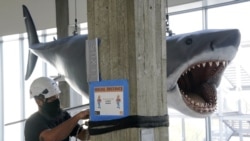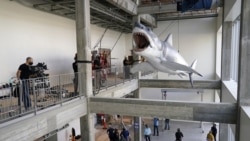The frightening creature from the 1975 American film “Jaws” has found a permanent home at a museum in Los Angeles.
Bruce the 45-year-old shark is 7.6 meters long and weighs 547 kilograms. He is famous for being hard to work with on the set of the classic film by director Steven Spielberg. Now, visitors to the Academy Museum of Motion Pictures will be able to see him for years to come.
Bruce was recently brought to the museum, his new home. But getting him ready to show was not easy. It took years of planning, including a seven-month restoration by special effects and makeup artist Greg Nicotero. The museum plans to open its doors to the public on April 30, 2021.
How Bruce got his name
Fans know that the “Jaws” crew started calling the shark Bruce after Spielberg’s lawyer Bruce Ramer. They will also know that the Bruce that museum-goers will see was technically not in the movie “Jaws.” He is a remake and is the last of his kind.
The three mechanical great white sharks designed by art director Joe Alves were destroyed when production for “Jaws” ended. But when the film proved to be a hit, a fourth shark was made. For 15 years he hung at Universal Studios Hollywood so visitors could take pictures with him. Then, he spent 25 years at the Sun Valley junkyard. Nathan Adlan, who took over his father’s junkyard business, donated the shark to the museum in 2016.
“One of the great things about being the Academy Museum of Motion Pictures is that we have access to Academy members” with many skills, said Bill Kramer. He is director of the museum.
These members and other people in the film industry helped restore creatures like Bruce, he said.
But Bruce was not exactly ready to face cameras. Twenty-five years in the California sun combined with years of being re-painted at Universal Studios had serious effects. He was badly in need of care and attention. Greg Nicotero said he joined the film business because of “Jaws” and volunteered to bring him back to life.
The restoration was not easy. Getting Bruce into the museum proved to be another problem. Bruce is the museum’s biggest object to date. But, everyone soon realized that he would not be able to get into the building with his fins attached.
Recently, Bruce was transported from a storage building on a special 21-meter bed to the museum. There, engineers, builders and art workers removed two large pieces of glass from the museum to get him into the building. Once inside, his fins were reattached.
Shraddha Aryal supervises design and production at the museum. She talked about the years of careful, detailed modeling and work that went into preparation. It included full-sized mock-ups and light tests to make sure that all of Bruce’s 116 teeth could be seen by visitors.
Seeing him lifted into the building was a wonderful experience, she said.
Because the museum expects Bruce to bring many visitors, he will hang in a place where the public can see him without paying. Almost 50 years after Bruce made children and adults afraid of getting into the water, he is now bringing film lovers to a museum.
“We plan on having Bruce greet our visitors for as long as we can keep him up there,” Kramer said. He hopes the creature will make people want to learn about the history of visual effects and how the shark was made.
“There are so many stories that can take you places just through this one object,” Kramer said.
I’m Alice Bryant.
The Associated Press reported this story. Alice Bryant adapted it for Learning English. Mario Ritter, Jr. was the editor.
________________________________________________________
Words in This Story
shark –n. a large and often dangerous fish with sharp teeth
restoration –n. the process of returning something to its earliest condition by repairing and cleaning it
junkyard –n. a place where you can buy, sell or leave things that have been thrown away
access –n. the ability to use something or to meet with someone
fin –n. a thin, flat extension from the body of a fish that it uses to control its movement in the water
mock-up –n. a full-sized model of something
greet –v. to meet with someone, or a group, that has just arrived; to welcome










